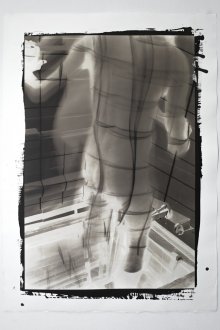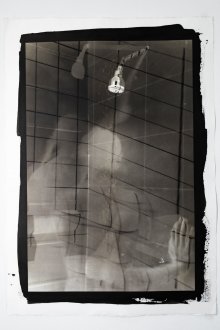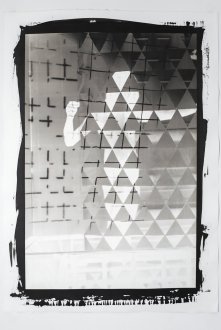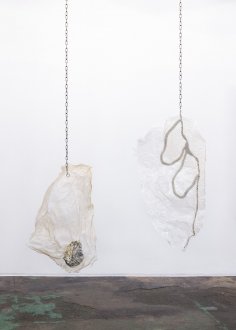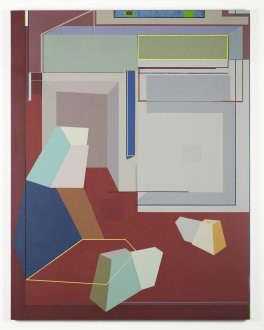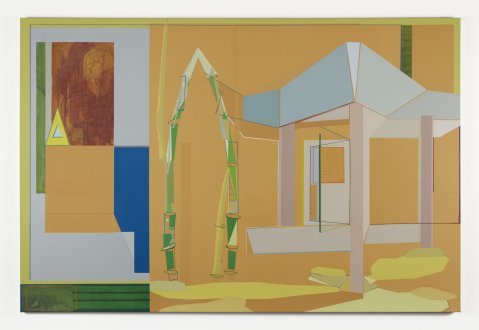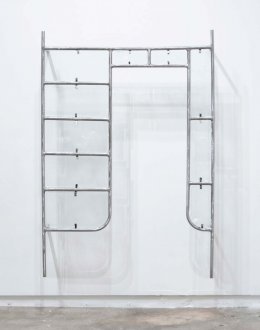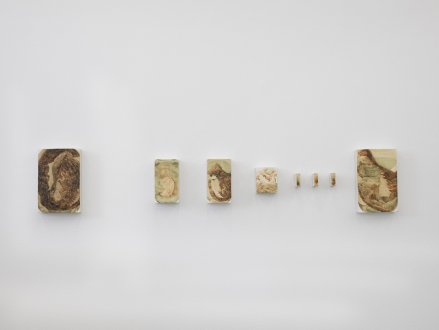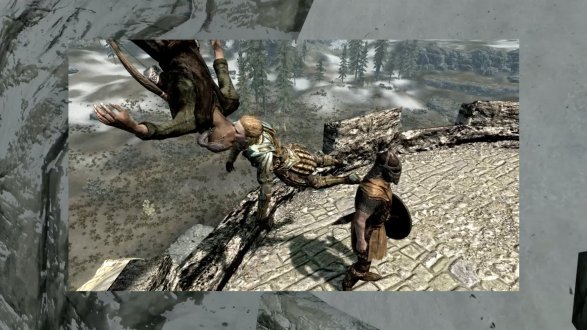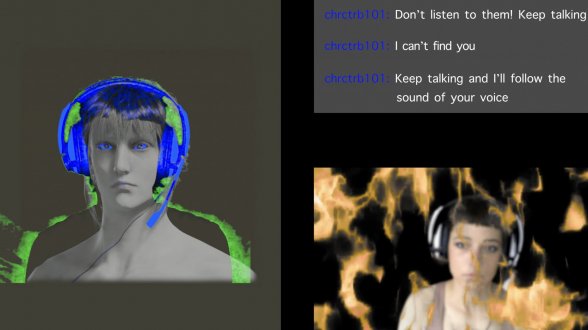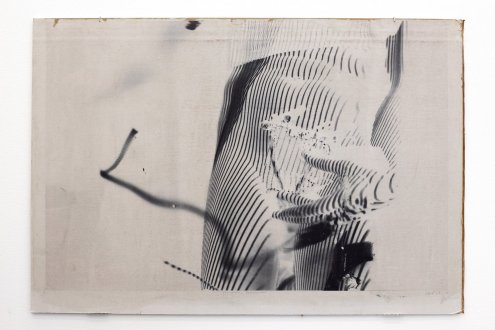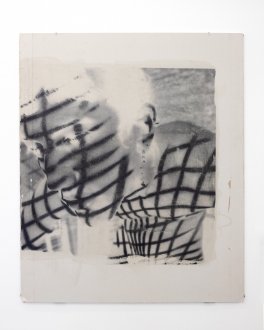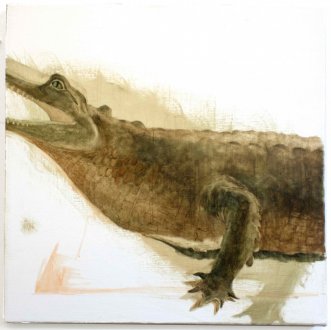Unfurled, 2023 (Works)
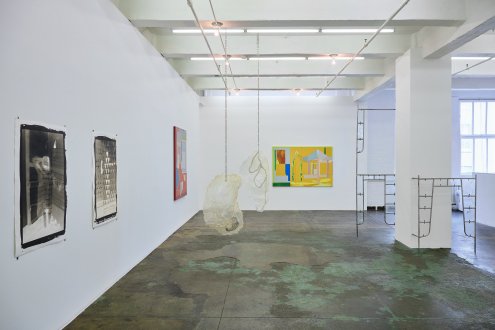
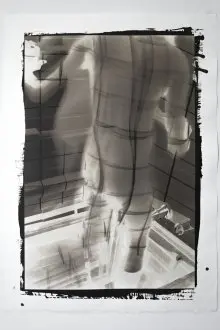 Projection II, 2021. Kallitype, palladium toned. 41 x 29.5 in. Edition of 5 (+1 AP).
Projection II, 2021. Kallitype, palladium toned. 41 x 29.5 in. Edition of 5 (+1 AP).
Opal Ecker DeRuvo is a nonbinary artist working with the materials, processes, and histories of photography. In the project presented in "Unfurled", DeRuvo projects laser beams in an evenly spaced grid structure unto their transfeminine body. Historically, grids were often used as backdrops in ethnographic photography or portraits as a method for assessing "types" or ethnic characteristics (a methodology not dissimilar to the use of digital datapoints in today's facial recognition technology). In projecting the laser generated structure onto the contours of their own body, DeRuvo upsets scientific "rationality", allowing for fluid representations of the self. They further obscure the "straight" reading of their likeness with the use of double exposures and additional light sources. DeRuvo uses historic photo-processes, such as kallitype, and sometimes transfers large-scale images onto architectural substrates like sheetrock (e.g. in the works “Gaze” and “Mechanical Reproduction”) connecting the materiality of photography with experiences of trans-embodiment.">
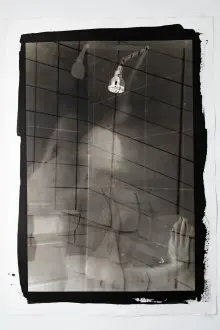 Projection I, 2021. Kallitype, palladium toned. 41 x 29.5 in. Edition of 5 (+1 AP).">
Projection I, 2021. Kallitype, palladium toned. 41 x 29.5 in. Edition of 5 (+1 AP).">
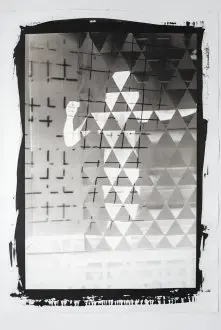 Projection III, 2021. Kallitype, palladium toned. 41 x 29.5 in. Edition of 5 (+1 AP).">
Projection III, 2021. Kallitype, palladium toned. 41 x 29.5 in. Edition of 5 (+1 AP).">
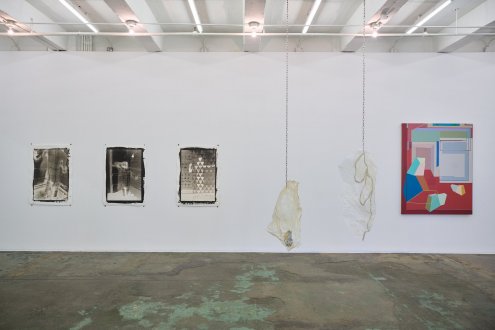
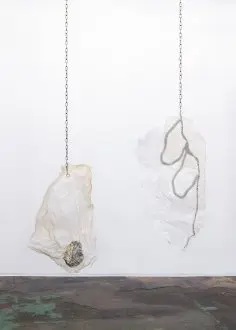 Saliva Makes Corals Dance in Fountains, and Body Armor (For Zachary).
Saliva Makes Corals Dance in Fountains, and Body Armor (For Zachary).
Andreia Santana's sculptures "Saliva Makes Corals Dance in Fountains" (left) and "Body Armor (For Zachary)" on the right are fashioned from liquid fish glue, which the artist spread out on the gallery's floor to dry. Though they were produced "impromptu", it is their sculptural qualities - their contours and the distortion of the now-dried puddles - which make them interesting as sculptures. The inlaid chains, from which they are suspended, speak to the general interests of the artist who often juxtaposes fragile with industrial materials. The stainless steel scaffoldings of her series of "Roof of Mouths" (see further installation views), for example, hold delicate glass plates molded from found organic or inorganic relics, including debris and wildlife.">
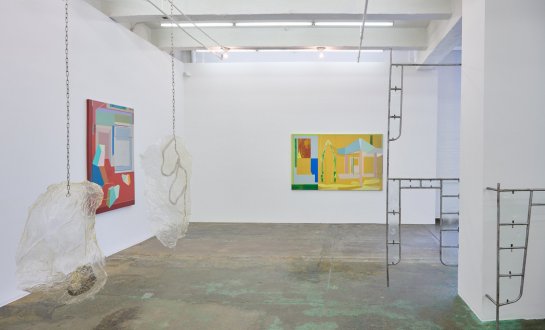
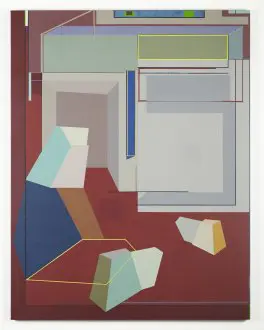 Untitled, 2023. Acrylic on canvas. 62 x 48.5 in.
Untitled, 2023. Acrylic on canvas. 62 x 48.5 in.
Sharon Yaoxi He translates into abstract language the way one would read, and thus "move through" a Chinese landscape painting. In a continued unfolding of architectural space, the artist invites viewers to imagine themselves in her scenes, incorporating a shifting perspective that moves up and down, near and far, or “around the corner”- in contrast to the central perspective used in Western tradition or the multi-perspectival, yet flattened space in Persian or Indian miniature painting.">
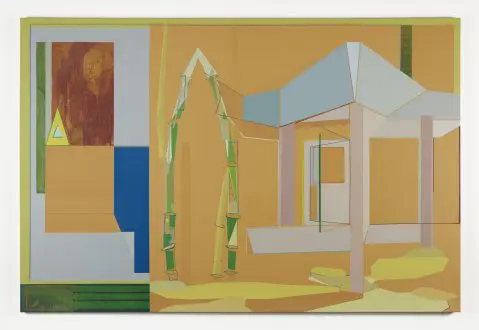 Inside a Line, 2023. Acrylic and pencil on canvas, 48 x 72 in.">
Inside a Line, 2023. Acrylic and pencil on canvas, 48 x 72 in.">
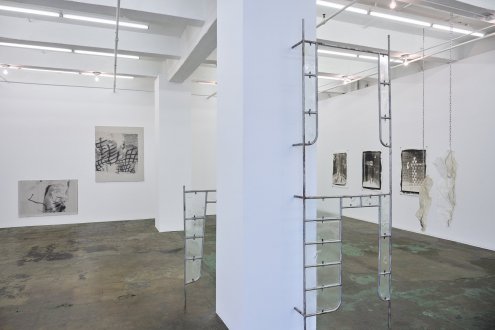
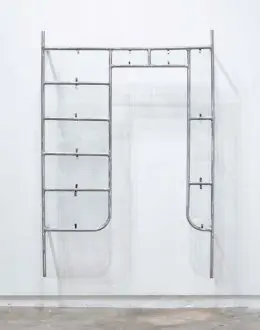 Roof of Mouth (#3), 2023. Steel and glass, 53 x 38 x 7 in.">
Roof of Mouth (#3), 2023. Steel and glass, 53 x 38 x 7 in.">
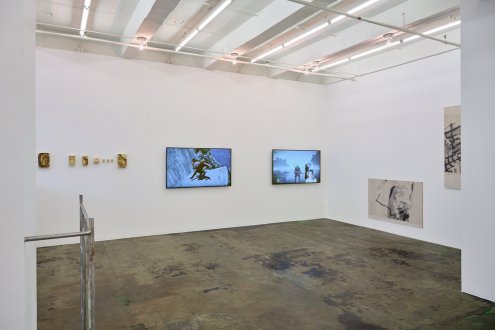
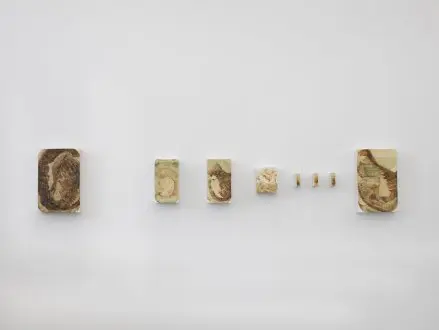 Peabody ‘Specimens’: Gharials and False Gharials, 2023. Oil on canvas, Dimensions variable: 8 canvases of varying sizes.
Peabody ‘Specimens’: Gharials and False Gharials, 2023. Oil on canvas, Dimensions variable: 8 canvases of varying sizes.
Though the subject of Khatri's paintings included in “Unfurled” are Gharials, it is the Mugger crocodile - also native to South Asia - which is housed and revered in a shrine in Karachi, a part of the identity of the city the artist grew up in. Specimens of Gharials are preserved in glass jars at the Yale Peabody Museum, where Khatri painted them in life sessions, choosing canvas formats which correspond to the sizes of their containers. Khatri's paint application is rather dry with each brush application building - stroke by stroke - a visually and rhythmically cohesive surface, not unlike the skin of the animals. It is important for the artist to paint in situ, directing their gaze to the object itself without the interference of another medium (such as a photography). The act of repeated looking, gradual discovery, and emotional engagement with the objects are foregrounded. There is a degree of nostalgia too involved in depicting these objects, now presented as a collection of specimens in a museum - taken out of their physical as well as spiritual context. Khatri contemplates our relationship to nature and its role as 'trophy' in the context of colonialism.">
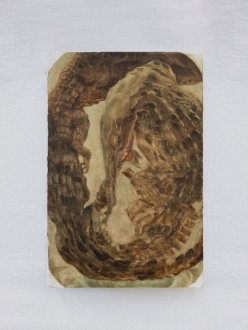
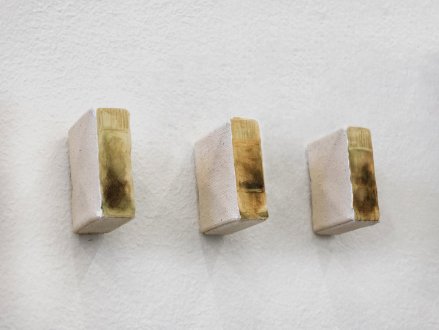
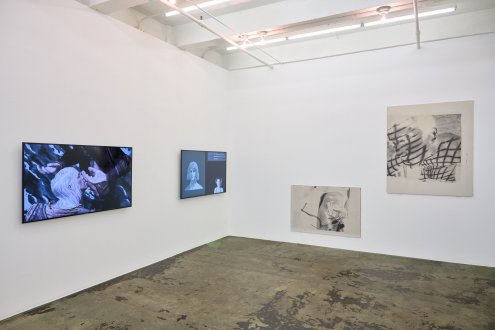
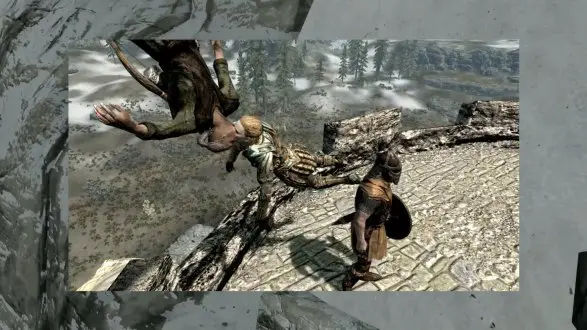 Intimacy Mod SuperCut, 2018. Video, 9 min 20 sec. Edition of 8.
Intimacy Mod SuperCut, 2018. Video, 9 min 20 sec. Edition of 8.
In her "Mod SuperCut", Kara Güt uses the modification (mod) “Immersive Lover’s Comfort” (by flexcreator) to allow her characters to kiss in the action role-playing game Skyrim.">
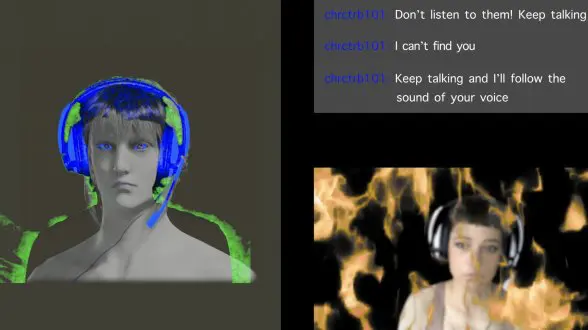 Hurt/Comfort, 2022. Video, 11 min 34 sec. Edition of 3.
Hurt/Comfort, 2022. Video, 11 min 34 sec. Edition of 3.
Güt speaks more generally to the lack of human intimacy in our mediated world. She confesses in “Hurt/Comfort”, how she sometimes confuses her in-game characters with her real life personality. This process is precipitated through her conversation with a chatbox that absorbs and feeds her ruminations back to her. "Hurt/Comfort" points to the ability of the bot to deliver comfort, yet remain devoid of actual human empathy. Using mediating technologies, Güt's work points towards a melancholic self reflectivity, which might be read as a prevailing mood of her generation.">
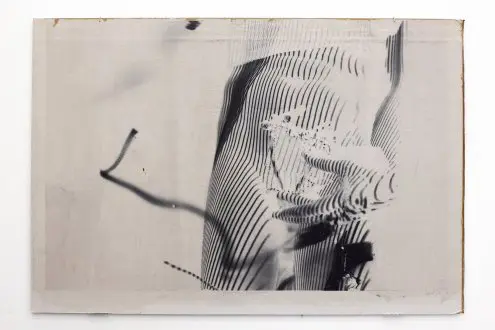 Mechanical Reproduction, 2022. Giclee transfer on drywall, 34.75 x 51 in.">
Mechanical Reproduction, 2022. Giclee transfer on drywall, 34.75 x 51 in.">
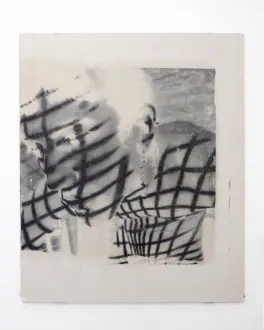 Gaze, 2022. Giclee transfer on drywall
58 x 48 in.
">
Gaze, 2022. Giclee transfer on drywall
58 x 48 in.
">
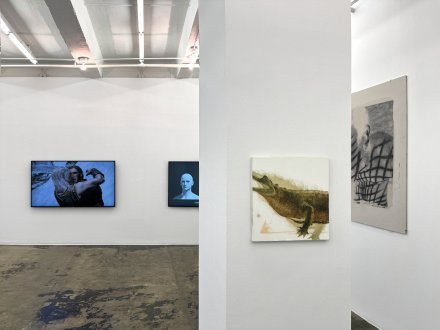
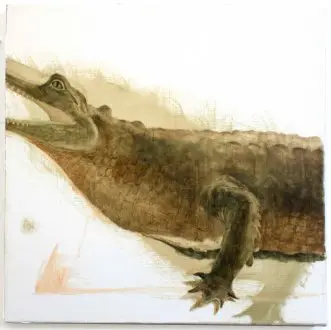 Taxidermied Gharial at the Peabody Museum, 2022. Oil on canvas, 18 x 18 in.">
Taxidermied Gharial at the Peabody Museum, 2022. Oil on canvas, 18 x 18 in.">
Selected Works
Opal Ecker DeRuvo, Kara Güt, Sharon Yaoxi He, Fiza Khatri, Andreia Santana
Opening reception: Thursday, July 13, 6 - 8 pm
Unfurled, 2023 Press Release
Thomas Erben Gallery is pleased to present Unfurled, an exhibition of works by Opal Ecker DeRuvo, Kara Güt, Sharon Yaoxi He, Fiza Khatri, and Andreia Santana, curated by the gallery’s Anthony Terzino, on view from July 13 through August 4, 2023. Embracing a wide range of mediums from photography, video, painting, and sculpture, unfurled explores the notion of history as a fluid, non-formalized entity. How might individual positions illuminate the ebb and flow of history to upend existing structures — or at the very least, devise a way out? Attention is drawn to the politics of subjectivity and knowing as they intersect with objects, bodies, and spiritual entities.
Opal Ecker DeRuvo uses lasers, frequency generators, and strobe lights to question photography’s role in structuring scientific knowledge and the collapsing of subjects into flattened identities in order to perform new gender subjectivities.
Kara Güt mixes image-based and digital media into virtual worlds to shape new forms of human intimacy. Using the mod “Immersive Lover’s Comfort” by flexcreator, Güt distorts the intended narrative of a role-playing game, opening up a multiplicity of identities that are possible at any given moment, and in any given character.
Meticulously constructed, Sharon Yaoxi He’s abstract paintings reveal and simultaneously conceal spatialities translated from Chinese landscape painting in a continued unfolding of architectural space, gesturing to what a painting never captures, never knows, and never can show.
Informed by the ethos and politics of feminist and queer space-making in Pakistan, Fiza Khatri’s paintings draw from taxidermy specimens found in museum ethnographies as well as poetic and sacred traditions to construct new fictions between the invented and the real.
Andreia Santana’s glass sculptures, cast from relics, debris, and wildlife affixed onto scaffold-like structures, appropriate techniques of archaeology to draw attention to the forgotten. Additionally, her ironed-out fish glue sculptures explore the use of this material and associated ritual practices that link the real to the supernatural.
Together these positions converge in a choreography of movements, each conjuring new possibilities.
(Anthony Terzino)
Opal Ecker DeRuvo is a transfeminine transdisciplinary artist. Their work has been shown at Childs Gallery and the Rivers Academy, both Massachusetts; The Center for Contemporary Printmaking, Connecticut; Boys Club, Berlin; The Westmoreland Museum of Art, Pennsylvania, Jeffrey Deitch, New York; and the International Print Center of New York. They received an MFA in Painting and Printmaking from Yale University, and has completed residencies at Atelier Circulaire, Montreal; and Ateliers im Alten Schlachthof, Germany.
Kara Güt is a multidisciplinary artist whose primary focus is image-based, digital media. Her work has been shown at Hybrid Box; Hellerau European Centre for the Arts, Dresden; Hesse Flatow, New York; Las Cigarreras Cultural Centre, Alicante; Azkuna Zentroa, Alhóndiga Bilbao; and the Museum of Contemporary Art, Detroit among others. She received an MFA from Cranbrook Academy of Art and is an alumni of Pioneer Works Tech Residency, the SPACES artist residency, and the Banff Visual + Digital Art residency. Kara lives and works in Ohio.
Fiza Khatri was born and grew up in Karachi, Pakistan. Their work has been shown at Jhaveri Contemporary; The Clemente Center and Olympia Gallery (both New York); IVS Gallery, Karachi; Lahore Biennale Collateral; The Research and Publication Centre, Lahore; and New York Studio School. They received an MFA in Painting and Printmaking from Yale University.
Sharon Yaoxi He is a Canadian painter born in China. She received a BFA from Emily Carr University of Art + Design and is currently an MFA candidate at Columbia University.
Andreia Santana is an artist living and working in New York. Santana received a MFA in Studio Art at Hunter College – City University of New York with a Fulbright/Fundação Carmona e Costa Grant, and a degree from ESAD – Caldas da Rainha and is an alumni of the Independent Study Program at the Maumaus School in Lisbon. Her work has been shown at CCB, Lisbon; Serralves Contemporary Art Museum, Porto; MAAT, Lisbon; In Extenso, Clermont-Ferrand; CIAJG, Guimarães; Hangar, Lisbon; Generali Milano, Milan; MACE Museu de Arte Contemporânea de Elvas, Elvas; Galeria Filomena Soares, Lisbon; Porto Municipal Gallery, Porto; UNA, Milan; Peninsula Art Space, New York; Galerias Municipais de Lisboa – EGEAC, Lisbon; Chiado 8, Lisbon; Culturgest, Porto/Lisbon; La Nave; Madrid, Hunter College Galleries, New York among others.
